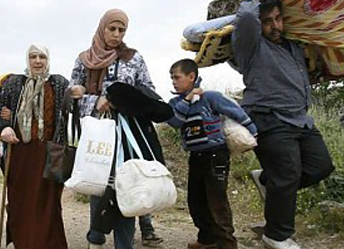As the civil war continues to unfold in Syria, a new refugee crisis is emerging with massive flows of Syrians escaping the country for relative safety in Turkey, Iraq, Jordan and Lebanon. Last week as many as 30,000 Syrian refugees crossed into Lebanon in just 48 hours while thousands more have crossed into Iraq, Jordan and Turkey. So far the official number of registered refugees from Syria is at 120,000 although it is believed the actual number is much higher.
Refugees are not new to the region; millions of Palestinian refugees live across the region, as do several hundred thousand Iraqi refugees and asylum seekers. In times of conflict like the Second Lebanon War in 2006, hundreds of thousands of Lebanese escaped to neighboring countries where some still remain. Thus the biggest surprise with the current situation in Syria is not that it happened, but rather that it didn’t happen sooner and refugee organizations were not better prepared. Fighting between the anti-regime Free Syrian Army and the government started in April last year, but it was not until heavy fighting reached Damascus that the trickle of refugees into neighboring countries became a deluge. The UN Refugee Agency already redrafted their emergency response plan in June after the original plan drafted in March became insufficient to deal with the rising numbers. Now, with the new flows entering Lebanon and Iraq, it appears that plan may also be insufficient as new arrivals struggle to gain access to food and supplies.
A serious consequence of this unpreparedness is the unwanted pressure on neighboring countries the crisis is creating. Iraq, concerned that the fighting would spill over the border, initially closed all border crossings with Syria last week only to re-open them to Syrian refugees yesterday. Yet the rash of bombings across Iraq yesterday highlight the potential danger in allowing refugees into the country, both for Iraqi who initially fled the sectarian violence there and for the government who cannot control who may cross over with fleeing Syrians. Similar fears exist in Lebanon, where sectarian fighting in recent months between Alawite and Sunni factions killed several people in Lebanon’s second largest city in an apparent spillover of the conflict in Syria.
Turkey is also facing difficult decisions over how to handle their share of the Syrian refugee population. Many of the 43,000 Syrians who escaped to Turkey since the conflict started are Kurds, many of which are aligned with the Democratic Union Party (PYD), a sister party to Kurdistan Workers Party that has battled the Turkish government for decades over the creation of an autonomous Kurdistan. Joining in the battle against Turkey is a natural choice for the PYD, who has already warned that it will fight any foreign intervention in Syrian Kurdistan. For now the PYD has agreed not to fight Turkey and instead focus its efforts on unseating the Syrian government, but how long that truce lasts remains to be seen. In the meantime, Turkey is now in the awkward position of hosting several thousand Syrians closely aligned with what they see as the largest domestic terrorist group in the country.
The conflict in Syria is still unfolding and the final outcome remains unclear, let alone the long term consequences. But the failure to fully anticipate the refugee flows out of Syria may be adding fuel to the fire in a region that does not need any more reasons to combust. More funding is needed to help regional governments handle the needs of Syrian fleeing the conflict but political support is needed as well. Otherwise, the nightmare scenario where the Syrian war overflows its borders into the rest of the region might just come true, and come via the thousands of refugees who have already lost everything except their anger, frustration and willingness to fight.
